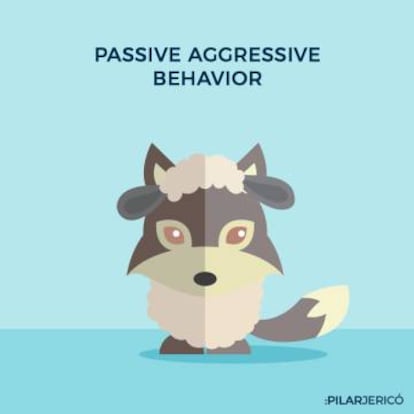How to spot a passive aggressive person in your life
Here are some tips on how to recognize this behavior and act with serenity and efficiency

There’s a party and your partner does not feel like going. He tells you that he’ll go, but he loses track of time so that when he is ready, the party is almost over. Or you maybe you work with a colleague who never sends reports through when you ask them to, and when you remind them, they play dumb. If you have lived through either of these situations, you already know about passive aggressive behavior, or silent treatment. We have all suffered through it and maybe even have been guilty of it ourselves. If such attitudes are the only way a person knows how to react, then they may be suffering from a disorder. But you don’t need to go to such extremes to suffer the effects of so-called silent treatment in everyday life.
In fact, “silent aggressiveness” is far more common than we imagine. We find it at work, with our friends and, of course, in our relationships. It can be the result of several factors: self-esteem issues, feelings of abandonment in childhood – usually by the mother – and through learned behaviors. Both men and women experience this. Passive aggressive behaviors are difficult to recognize with the naked eye, but they are very painful to the person targeted and to themselves. Let’s see how these people act to try and understand them.
Behind this attitude there is pain, pride and fear that prevents people from expressing their real needs
Silence is their main weapon
A passive aggressive person gets angry like any other mortal, but will not verbalize it and instead expresses it in another way – that is, by ignoring the other person for long periods. Behind this attitude there is pain, with a mixture of pride and fear that prevents them from expressing their real needs. In this way, if a third party exposes the conflict to the light of day, they will refuse to speak of it. They will deny it, or pretend it does not exist.
With you but without you
Passive aggressive people are highly dependent, even if they do not realize it. They like to be looked after, but at the same time, they want freedom and autonomy, and to not be given orders. That lends an often ambivalent and inconsistent character to what they say or to their expectations of other people.
Hidden aggression
Their difficulty in expressing what they want and their dependence and anger when they do not feel wanted can be a ticking time bomb in personal relationships. It leads them to employ non-confrontational strategies: they do not speak, they do not pay attention to the other person, and they forget what they have been told… If the other person confronts their behavior, they will look for an easy way out of the discussion, through denial.
Victim-hood in its pure state
A passive aggressive person has a hard time recognizing what is happening to them and to others. Their lack of self-criticism and flexibility leads them to believe that they are right and the rest of the world is responsible for what is happening to them.
What should we do about passive aggression?
Use these three strategies. Firstly, recognize when the other person has fallen into that state and let it pass. If you need to argue or make them see that they are wrong, you are lost: passive aggressive people will close themselves off even more – so it is important to give it time. Their fear of abandonment will make them retreat at some point.
Passive aggressive people will close themselves off even more if you argue with them
Second, give yourself space. Do not take someone’s passive aggressiveness as a personal attack, but view it as a response to their pain mixed with difficulty in expressing it. Even if it hurts you, look at them with compassion.
The third strategy, to use – when the intensity of their behavior has lessened – is to reason with them calmly, without resorting to personal accusations. Explain what happens to you when they act that way. The aim is to find joint solutions. Logically, if this attitude occurs with great regularity, the best option is to seek professional help.
In short, silent aggression is very frequent and very painful. It is not necessary to have a disorder for it to manifest. As long as we know how to recognize this behavior in other people, or even in ourselves, we will know how to act with greater serenity and effectiveness.
English version by Debora Almeida.
Tu suscripción se está usando en otro dispositivo
¿Quieres añadir otro usuario a tu suscripción?
Si continúas leyendo en este dispositivo, no se podrá leer en el otro.
FlechaTu suscripción se está usando en otro dispositivo y solo puedes acceder a EL PAÍS desde un dispositivo a la vez.
Si quieres compartir tu cuenta, cambia tu suscripción a la modalidad Premium, así podrás añadir otro usuario. Cada uno accederá con su propia cuenta de email, lo que os permitirá personalizar vuestra experiencia en EL PAÍS.
¿Tienes una suscripción de empresa? Accede aquí para contratar más cuentas.
En el caso de no saber quién está usando tu cuenta, te recomendamos cambiar tu contraseña aquí.
Si decides continuar compartiendo tu cuenta, este mensaje se mostrará en tu dispositivo y en el de la otra persona que está usando tu cuenta de forma indefinida, afectando a tu experiencia de lectura. Puedes consultar aquí los términos y condiciones de la suscripción digital.










































